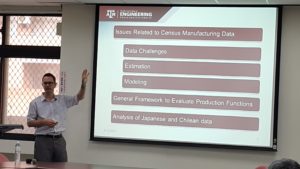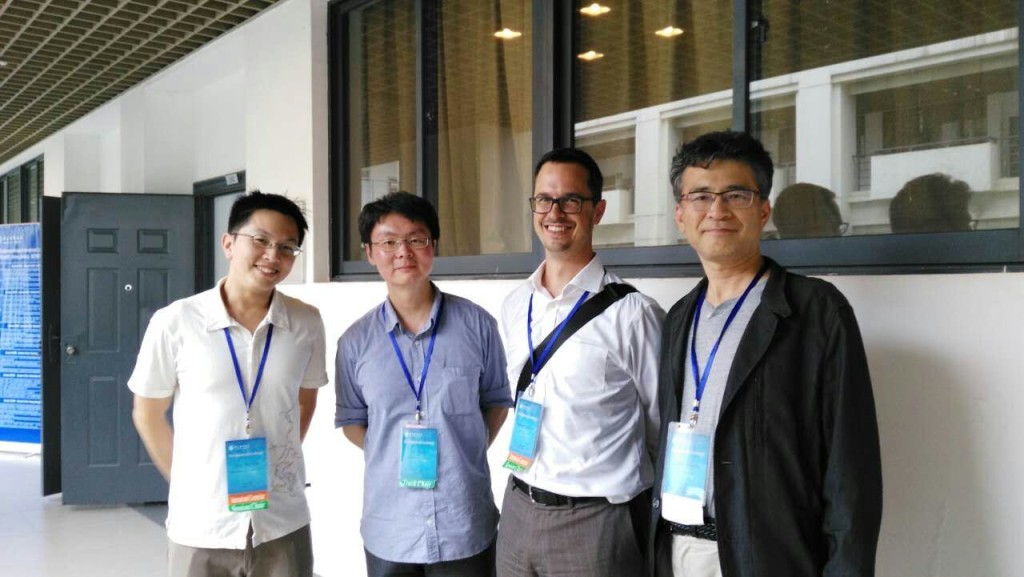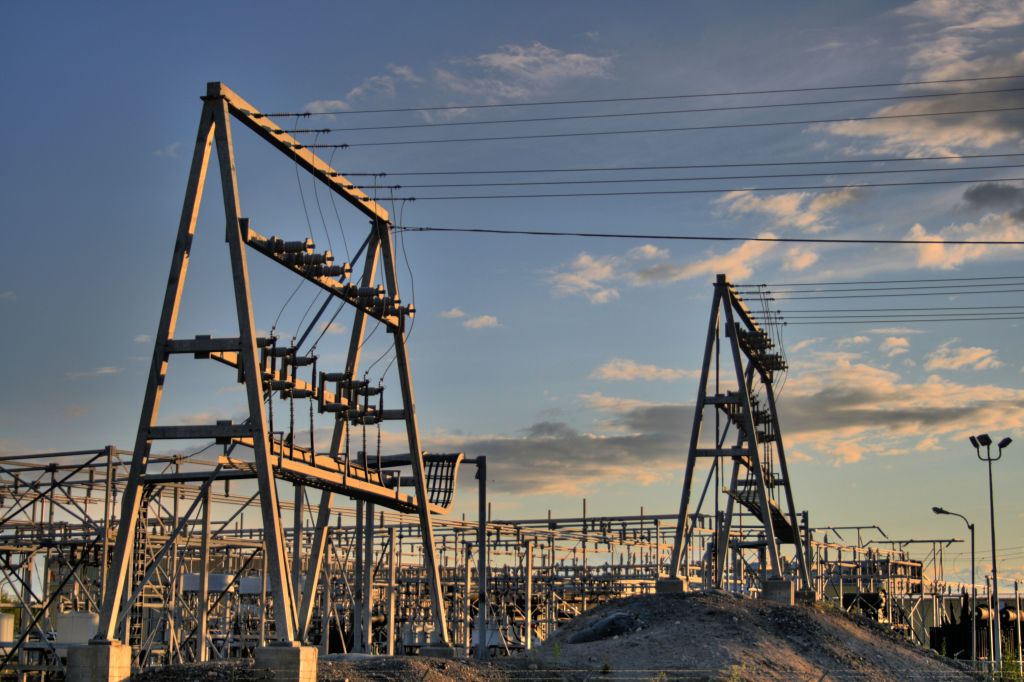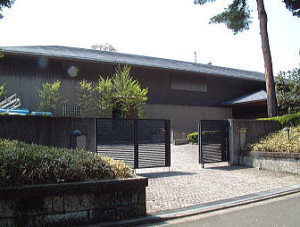More details to come.
Category Archives: Seminars
March 6 – Department of Industrial and Systems Engineering, Virginia Tech – Regulating Local Monopolies in Electricity Distribution: An Application of Shape Constrained Regression
The Finnish electricity market has a competitive energy generation market and a monopolistic distribution system. To regulate the local monopoly power of network operators, the government regulator uses frontier estimation methods to identify excessive distribution costs, taking into account outputs and the operating environment. We describe the new regulatory system developed for the Finnish regulator, which is based on shape constrained nonparametric functional estimation and utilizes panel data to detect the excessive costs from random noise.
The literature of productive efficiency analysis is divided into two main branches: the parametric SFA and nonparametric DEA. A new method is proposed, Stochastic Nonparametric Envelopment of Data, StoNED, that combines the virtues of both DEA and SFA in a unified approach to frontier analysis. StoNED follows the SFA approach by including a stochastic component. In contrast to SFA, however, the proposed method does not make any prior assumptions about the functional form of the production function. In that respect, StoNED is similar to DEA, and only imposes free disposability, convexity, and some returns to scale specification.
The main advantage of the StoNED approach to the parametric SFA approach is the independence of the ad hoc parametric assumptions about the functional form of the production function (or cost/distance functions). In contrast to the flexible functional forms, one can impose monotonicity, concavity and homogeneity constraints without sacrificing the flexibility of the regression function. Additionally, the main advantage of StoNED to the nonparametric DEA approach is robustness to outliers, data errors, and other stochastic noise in the data. In DEA the frontier is spanned by a relatively small number of efficient firms, however, in our method all observations influence the shape and level of the frontier. Also many standard tools from parametric regression such as goodness of fit statistics and statistical tests are directly applicable in our approach. This is collaborate work with Timo Kuosmanen of Aalto University in Finland.
February 1 – Department of Economics, Rice University – Regulating Local Monopolies in Electricity Distribution: An Application of Shape Constrained Regression
The Finnish electricity market has a competitive energy generation market and a monopolistic distribution system. To regulate the local monopoly power of network operators, the government regulator uses frontier estimation methods to identify excessive distribution costs, taking into account outputs and the operating environment. We describe the new regulatory system developed for the Finnish regulator, which is based on shape constrained nonparametric functional estimation and utilizes panel data to detect the excessive costs from random noise.
The literature of productive efficiency analysis is divided into two main branches: the parametric SFA and nonparametric DEA. A new method is proposed, Stochastic Nonparametric Envelopment of Data, StoNED, that combines the virtues of both DEA and SFA in a unified approach to frontier analysis. StoNED follows the SFA approach by including a stochastic component. In contrast to SFA, however, the proposed method does not make any prior assumptions about the functional form of the production function. In that respect, StoNED is similar to DEA, and only imposes free disposability, convexity, and some returns to scale specification.
The main advantage of the StoNED approach to the parametric SFA approach is the independence of the ad hoc parametric assumptions about the functional form of the production function (or cost/distance functions). In contrast to the flexible functional forms, one can impose monotonicity, concavity and homogeneity constraints without sacrificing the flexibility of the regression function. Additionally, the main advantage of StoNED to the nonparametric DEA approach is robustness to outliers, data errors, and other stochastic noise in the data. In DEA the frontier is spanned by a relatively small number of efficient firms, however, in our method all observations influence the shape and level of the frontier. Also many standard tools from parametric regression such as goodness of fit statistics and statistical tests are directly applicable in our approach. This is collaborate work with Timo Kuosmanen of Aalto University in Finland.
November 14 – Informs Annual Meeting – Insights from Machine Learning for Evaluating Production Function Estimators on Manufacturing Survey Data

I have presented this paper at several conferences recently.
Abstract: In this paper we propose selecting an estimator based on a weighting of its in-sample and predictive performance on actual application datasets. For simulated data, we find that our proposed estimator has the lowest weighted errors. For actual data, specifically the 2010 Chilean Annual National Industrial Survey, a Cobb-Douglas specification describes at least 90% as much variance as the best alternative estimators in practically all cases considered.
August 12 – Institute of Manufacturing, National Cheng Kung University – Insights from Machine Learning for Evaluating Production Function Estimators on Manufacturing Survey Data

Abstract: In this paper we propose selecting an estimator based on a weighting of its in-sample and predictive performance on actual application datasets. For simulated data, we find that our proposed estimator has the lowest weighted errors. For actual data, specifically the 2010 Chilean Annual National Industrial Survey, a Cobb-Douglas specification describes at least 90% as much variance as the best alternative estimators in practically all cases considered.
July 21 and 28 – Osaka University – Lectures on Regression as a Special Case of Quadratic Programming

Students in operations research and industrial engineering typically study linear and non-linear programming. Whereas regression is more commonly used in the fields of statistics and econometrics. This lecture will describe the relationship between the two methodologies.
July 4 – Data Envelopment Analysis International Conference – Insights from Machine Learning for Evaluating Production Function Estimators on Manufacturing Survey Data

Abstract: In this paper we propose selecting an estimator based on a weighting of its in-sample and predictive performance on actual application datasets. For simulated data, we find that our proposed estimator has the lowest weighted errors. For actual data, specifically the 2010 Chilean Annual National Industrial Survey, a Cobb-Douglas specification describes at least 90% as much variance as the best alternative estimators in practically all cases considered.
June 15 – North American Productivity Workshop – Insights from Machine Learning for Evaluating Production Function Estimators on Manufacturing Survey Data

Abstract: In this paper we propose selecting an estimator based on a weighting of its in-sample and predictive performance on actual application datasets. For simulated data, we find that our proposed estimator has the lowest weighted errors. For actual data, specifically the 2010 Chilean Annual National Industrial Survey, a Cobb-Douglas specification describes at least 90% as much variance as the best alternative estimators in practically all cases considered.
May 18 – Nonparametric statistical inference under shape constraints Workshop – Production Function Estimation Using Shape Constrained Estimators

Production functions are economic models to characterize the relationship between resources consumed and output produced for production processes. Economic theories of production rarely provides guidance for a particular functional form; however, many economic theories provide shape restrictions on the production function. The specific shape restrictions vary across production processes. This talk will provide an overview of the most common shape restrictions and motivation for their use.



